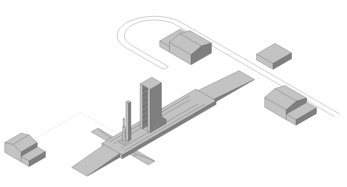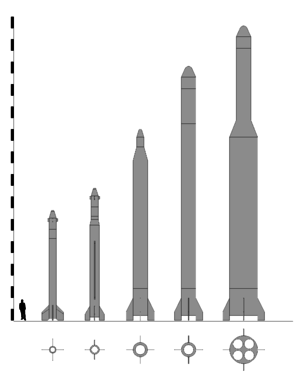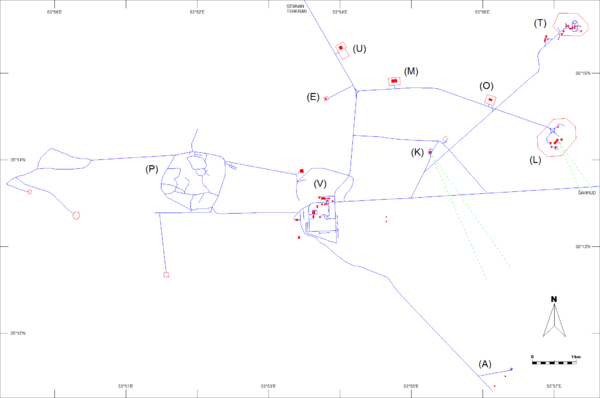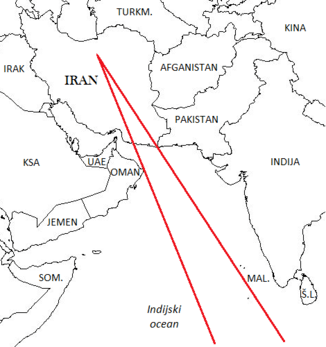Semnan Space Center
Coordinates: 35°14′04″N 53°55′15″E / 35.234440°N 53.920798°E
| Owner |
Iranian Space Agency, |
|---|---|
| Established | February 1, 2004 |
| Primary spaceport | Imam Khomeini Spaceport |
| Website |
isa |
Semnan Space Center (Persian:پایگاه فضایی سمنان) is the primary Iranian Space Center, located 50 km southeast of the city of Semnan in the north of the country.
History
On occasion of the 10th anniversary of the 1998 Kwangmyongsong 1 satellite launch attempt, program conducted by North Korea in close cooperation with Iran and Pakistan, the Iranian Space Agency has proceeded with its own test. According to practice also observed by North Korea, Iranian authorities announced to their Chinese allies on August 16, 2008 the imminent launch of a satellite.[1] On August 17, 2008 on the occasion of the birthday anniversary of Shia's 12th Imam Mahdi, Iran proceeded as preannounced with the second test launch of a three stages Safir SLV from a site 35°14′5″N 53°55′15″E / 35.23472°N 53.92083°E south of Semnan in the northern part of the Dasht-e-Kavir desert. Reza Taghizadeh, head of the Iranian Aerospace Organization, told state television "The Safir (Ambassador) satellite carrier was launched today and for the first time we successfully launched a dummy satellite into orbit".[2] As reported in late 2009 and early 2010, a new, larger launch pad was under construction at 35°15′30″N 53°57′17″E / 35.25833°N 53.95472°E[3][4]
Launch history
| Date | Carrier rocket | Payload | Pad | Outcome | Note |
|---|---|---|---|---|---|
| November 2, 2006 | Kavoshgar-1 (A) | No Payload | mobile | Success | Atmospheric flight (v = 10 km)[5] |
| February 25, 2007 | Kavoshgar-1 | mobile | Success | First Mesosphere flight[6] | |
| February 4, 2008 | Kavoshgar-1 | No Payload | mobile | Success | First flight above Kármán line[6] |
| August 16, 2008 | Safir-1 | circular | Success | First Iranian object in Orbit[7] | |
| November 26, 2008 | Kavoshgar-2 (B) | empty bio capsule | mobile | Success | Atmospheric flight (v = 40 km)[5] |
| February 2, 2009 | Safir-1 | circular | Success | First operational Iranian Satellite[6] | |
| February 3, 2010 | Kavoshgar-3 (B) | mobile | Success | Atmospheric flight (v = 55 km)[5] | |
| March 15, 2011 | Kavoshgar-4 (C) | empty bio capsule | mobile | Success | Suborbital flight (v = 135 km)[5] |
| June 15, 2011 | Safir-1A | circular | Success | Operating satellite[6] | |
| September 15, 2011 | Kavoshgar-5 (C) | mobile | Failure | Suborbital flight (v = 120 km)[5] | |
| February 3, 2012 | Safir-1B | circular | Success | Operating satellite[6] | |
| May 23, 2012 | Kavoshgar-6 (C) | mobile | Failure[8] | Suborbital flight (v = 120 km)[5] | |
| January 28, 2013 | Kavoshgar-7 (C) | mobile | Success | Suborbital flight (v = 120 km)[5] | |
| December 14, 2013 | Kavoshgar-8 (D) | circular | Success | Suborbital flight (v = 120 km)[5] | |
| February 2, 2015 | Safir-1B | circular | Success | Operating satellite[9] | |
| April 19, 2016 | Simorgh | No Payload | Main | Success | Suborbital flight[10] |
| July 27, 2017 | Simorgh | No Payload | Main | Failure[11] | Test flight; second stage failed[12] |
Launch Sites

Circular Launch Platform
The circular launch platform is the oldest launch pad and also recognizable by the light blue background with the original logo of the Iran Space Agency (ISA).The platform has a simplified character and consists of a leveled terrain with a circular asphalted section of a diameter of 65 m, at the center of which is a service tower.
Main Launch Platform

- fuel tank (piped drains)
- launch ramp with Simorgh
- auxiliary service facilities
The main launch Platform is located at the east of the complex on a specially enclosed octagonal area measuring 900 x 660 m and covering an area of 51.4 ha, representing the largest single element of the new space center.The units are accessed by a road from the northwest, which is within the perimeter of the three rays and forms two main inner zones – almost completely built lower and newly initiated upper (state of 2015). The lower zone consists of spacious launching platforms with towers and four larger compartments for installation and storage.

| Map of the Semnan Space Center | |
|---|---|
 |
Legend: Road communication Main facilities and installations Inclination launch (55–66 °) Installations:(A) – Antennas for communications(35°11′34″N 53°56′21″E / 35.19278°N 53.93917°E) (E) – Distribution substations (35°14′42″N 53°53′48″E / 35.24500°N 53.89667°E) (K) – Circular launch pad (35°14′5″N 53°55′15″E / 35.23472°N 53.92083°E) (L) – The main launch pad(35°14′14″N 53°57′0″E / 35.23722°N 53.95000°E) (M) – Drive mounting rocket (35°14′53″N 53°54′46″E / 35.24806°N 53.91278°E) (O) – Operations Center (35°14′41″N 53°56′6″E / 35.24472°N 53.93500°E) (P) – Polygon ballistic missiles (35°13′46″N 53°51′58″E / 35.22944°N 53.86611°E) (T) – test Center for rocket motors (35°15′31″N 53°57′15″E / 35.25861°N 53.95417°E) (U) – Administrative Center (35°15′15″N 53°54′0″E / 35.25417°N 53.90000°E) (V) – Military administrative and technical center (35°13′21″N 53°53′45″E / 35.22250°N 53.89583°E) |
References
- ↑ "伊朗将于下周发射自主生产的卫星". 伊通社. August 16, 2008. Archived from the original on September 12, 2008. Retrieved August 18, 2008.
- ↑ "Iran says it has put first dummy satellite in orbit". Reuters. Retrieved 2008-08-18.
- ↑ Massive Construction Visible at Iran's Missile & Space Center at Semnan
- ↑ Imagery of Construction of New Launch Site in Iran
- 1 2 3 4 5 6 7 8 (in Persian) ARI (December 17, 2014). "تاریخچه کاوشگر ایرانی: پژوهشکده سامانههای فضانوردی و یکدهه سابقه پرتاب محمولههای فضایی". Tehran: پژوهشکده سامانه های فضانوردی. Archived from the original on December 19, 2013. Retrieved 2015-12-21.
- 1 2 3 4 5 (in English) Hildreth, Steven A. (6 December 2012). Iran's Ballistic Missile and Space Launch Programs (PDF). CRS report for Congress. R42849. Washington, DC: Congressional Research Service (CRS), Library of Congress. pp. 13–14, 32, 39–44. i 57–58. OCLC 822732797.
- ↑ (in English) Harding, Robert C. (2013). Space Policy in Developing Countries: The Search for Security and Development on the Final Frontier. Space Power and Politics. Milton Park, Abingdon, Oxfordshire; New York: Routledge. p. 131. ISBN 9780415538459. OCLC 773023787.
- ↑ Hansen, Nick (November 21, 2012). "Rocket science – Iran's rocket programme". Jane's Intelligence Review. 24 (11).
- ↑ (in English) Press TV (2 February 2015). "Iran successfully places domestically-made Fajr satellite into orbit". Tehran: Press TV. Retrieved 21 December 2015.
- ↑ (in English) Eshel, Tamir (24 April 2016). "Simorgh First Launch – an Iranian Success or Failure?". Qadima: Defense Update. Retrieved 28 July 2017.
- ↑ Krebs, Gunter. "Simorgh (Safir-2)". Gunter's Space Page. Retrieved December 15, 2017.
- ↑ (in English) Press TV (27 July 2017). "Watch moment Iran successfully launches Simorgh satellite carrier". Tehran: Press TV. Retrieved 28 July 2017.
